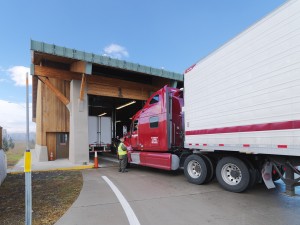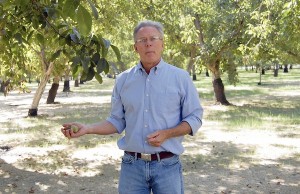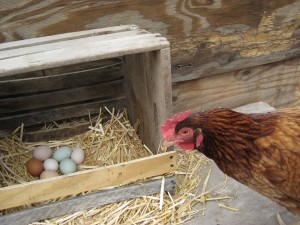http://www.nytimes.com/2012/10/17/dining/raising-sought-after-snails-in-california.html
EVEN if you love eating snails, it is possible that you have never given much thought to the way they live.
Maybe you assume that they are weak and slow, enduring lives of quiet desperation, as Thoreau once described the bulk of humanity. If so, Mary Stewart, a snail rancher whose mollusks are sought after by top chefs all over the country (including Daniel Boulud and Thomas Keller), will not hesitate to set you straight.
“They are the loudest, noisiest munchers you’ve ever heard,” she said on a hot Central Valley morning, smoking a cigarette in a small air-conditioned room attached to a farm stand a few steps from her house.
Chefs at restaurants like Tertulia and Vinegar Hill House in New York, Moto in Chicago and the Walrus and the Carpenter in Seattle cook with her snails because of the care she puts into cultivating and cleaning them. That attention to detail fosters tenderness, an absence of grit and a fresh taste with, at times, a very slight note of basil.
But it’s hard to imagine what it actually means to care for snails unless you visit Ms. Stewart, who lives in a mobile home in this agricultural area north of Bakersfield, Calif. To raise delicious snails, you apparently have to know what makes them tick, and Ms. Stewart, who turned 64 a few weeks ago, has spent a couple of decades educating herself.
She has learned that snails can move a lot faster than their reputation would suggest, especially when they pick up the lure of food. Spray them with mist, give them some crisp lettuce and “here they come, just like cows at feeding time,” she said. “You can hear them munching and crunching just like cattle. I’m serious. They’re fascinating. And they’re so strong.”
Strong? “These puppies can really push,” she said. Don’t expect to contain them in, say, a box with a screen set on top. “If enough of them get up in the corner, they can actually push that screen loose.”
They also lead erotic lives of variety and vigor. “They’re hermaphrodites,” she said. “They have orgies. I’m serious. When they mate, they’re connecting male and female, female and male.”
It may often look as if snails aren’t doing anything. Ms. Stewart has learned that they are doing quite a bit. “That’s all they’re doing, is making love,” she said.
As part of their ritual of copulation, snails shoot each other with something known as a “love dart.” “Love” is certainly a word you could use to describe how Ms. Stewart feels about her gastropod herd, but after years of caring for and harvesting thousands of snails, she has figured out that there’s nothing romantic about letting one of those love darts pierce your skin.
“It’s like a splinter,” she said. “It hurts. I shoved one under my finger one time because I was cleaning the bin. Oh, that sucker was sore for weeks.”
Although she lives far away from any nexus of fine dining, results of Ms. Stewart’s labor (and suffering) can be found on many ambitious menus.
Nathan Myhrvold, the man behind the “Modernist Cuisine” cookbooks, has cooked with her snails. Harold Dieterle has sporadically served them at Perilla, in the West Village, with hand-cut pasta and guanciale.
At Moto, in Chicago, the chef de cuisine, Richie Farina — using branches that he collects in the nearby woods — places the snails in a row so that they appear to be crawling up the stick in a tangle of (depending on what arrives from the distributor that week) wild mushrooms, edible flowers, a variety of greens and a garlic-herb “moss.” In a less theatrical mode, Brian Leth, the chef at Vinegar Hill House in Brooklyn, pairs the snails with olive-oil-poached baby artichokes on flatbread.
“It’s not an ingredient I would ever cook with unless I could get something of this quality,” Mr. Leth said.
A signature dish at Tertulia, Seamus Mullen’s Asturian-cider-house-style restaurant in the West Village, is arroz a la plancha, a sort of griddle-crisped risotto in which Ms. Stewart’s snails emerge as earthy nubs of texture within a mound of rice, mushrooms and jamón Ibérico. Compared with canned snails, which Mr. Mullen finds “disgusting,” Ms. Stewart’s impart an herbal undercurrent and a “funky nuttiness” without the ick factor of interior grit.
“They’re purged really well,” he said. “That’s a big part of it.”
Many chefs catch word about Ms. Stewart’s snails through a distributor, Mikuni Wild Harvest, a Seattle-based company that started nine years ago to bring foraged foods to cooks. (Through its Web site, Mikuni sells partly precooked shipments of the snails for $39.75 a pound.) Tyler Gray, one of the company’s founders, said the sales representatives tap into Ms. Stewart’s snail lore to help get chefs intrigued.
“She’s a pretty eccentric woman — and in love with her snails,” he said. “She is one of these people who are so passionate about what they do that it can’t help but be infectious.” It also doesn’t hurt that she may have cornered the market.
“If chefs are not using Mary’s fresh snails, then they are most likely using a canned product from France,” Mr. Gray said. Ms. Stewart is flattered whenever she hears of another chef getting on board (“It’s gratifying to know that my product is wanted and appreciated,” she said) even if she’s more inclined to heat up her mollusks in Pepperidge Farm pastry shells with some shallots, parsley and sweet butter.
She owes her induction into the snail realm to an epiphany. It came one December day in 1981 when she picked up the food section of The Bakersfield Californian and saw a headline: “Escargot … Watch Them Go!” Other readers might have tittered or recoiled, but Ms. Stewart read the accompanying recipes, and something clicked.
“I said, ‘I want to make some of these dishes,’ ” said Ms. Stewart, who has saved a copy of the section for more than 30 years.
The idea of eating snails did not seem unusual to a woman whose childhood was spent in the bayous of Arkansas. “I was raised in the South, honey, and let me tell you, we grew up on red squirrel, venison, frog’s legs,” she said. “We were dirt poor. The one thing I’ve never eaten is possum. When I saw the article, to me the recipes sounded good. I’d never eaten snails, but I wanted to try them.”
After a while, she realized that she was surrounded by the very bumper crop she longed for: the garden snails known as Helix aspersa roamed free throughout the orchards of the Central Valley, and were viewed as leaf-munching pests.
European settlers are believed to have originally brought this invasive species to America as food — so couldn’t Ms. Stewart make use of them? She sought the advice of experts, including an entomology professor at the University of California, Riverside, and in 1989 began a career as a snail rancher.
“It took at least, I’d say, 15 years to learn how to raise them and grow them and get the job done right,” she said. “Because there were really no books on it.”
Snails may come across as barely sentient, but over time Ms. Stewart learned that they are highly sensitive. They get claustrophobic. Pen up too many in a tight space, and they start to slide into panic-induced die-offs.
“When they get overcrowded, they put off an odor,” she said. “Many of them drop dead and the rest of them stay alive. It took me a long, long time to figure that all out.”
How to purge them so that “their bellies are clean,” how to maintain the right temperature so they don’t freeze up or freak out, what to feed them (they go crazy for watermelon): it took Ms. Stewart a long time to become an expert on those matters, too.
Which is why she resists letting visitors know many of her trade secrets, including the precise location of the herd.
“There’s certain things I’m not going to tell you,” she said. (Her distributors advertise her product as “basil-fed snails,” but basil is by no means the only thing she feeds them, and a faint trace of herb probably comes from a different part of the process.)
“The secret of raising snails?” she went on. “Snails do what they want to do when they want to do it. As soon as I feel like I really know snails well, they’ll turn around and do something I’ve never seen them do before.”
After holding court for a while, Ms. Stewart got up from her chair and walked over to a refrigerator. She opened it, grabbed a glass jar, opened that and poured its shiny, slithering contents into a bowl.
“You’re welcome to taste some, if you want,” she said. “Escargot caviar!”
Who knew? Snails lay eggs, and Ms. Stewart has dreams of selling their pearl-like pellets to chefs who keep up a constant quest for odd new ingredients. (When the eggs pop in the mouth, they release a liquid that tastes milder than the briny fluid inside salmon roe.)
“The snail caviar is really cool,” said Mr. Gray of Mikuni. “There is no one else in North America who’s doing that. I think it’s going to be one of those exceptional products, and chefs are going to be fighting over it.”
Then again, it’s hard to say how much longer Ms. Stewart, whose husband, Vernon, died in February, will remain committed to the careful shepherding of mollusks. The snail trade has its downside.
“Harvesting snails is one of the dirtiest jobs in the world,” she said. Which is why, not long ago, she found herself mulling the idea of retirement — and wondering how she might spend her days.
“Guess what I was going to do?” she said. “I was going to raise butterflies.”









